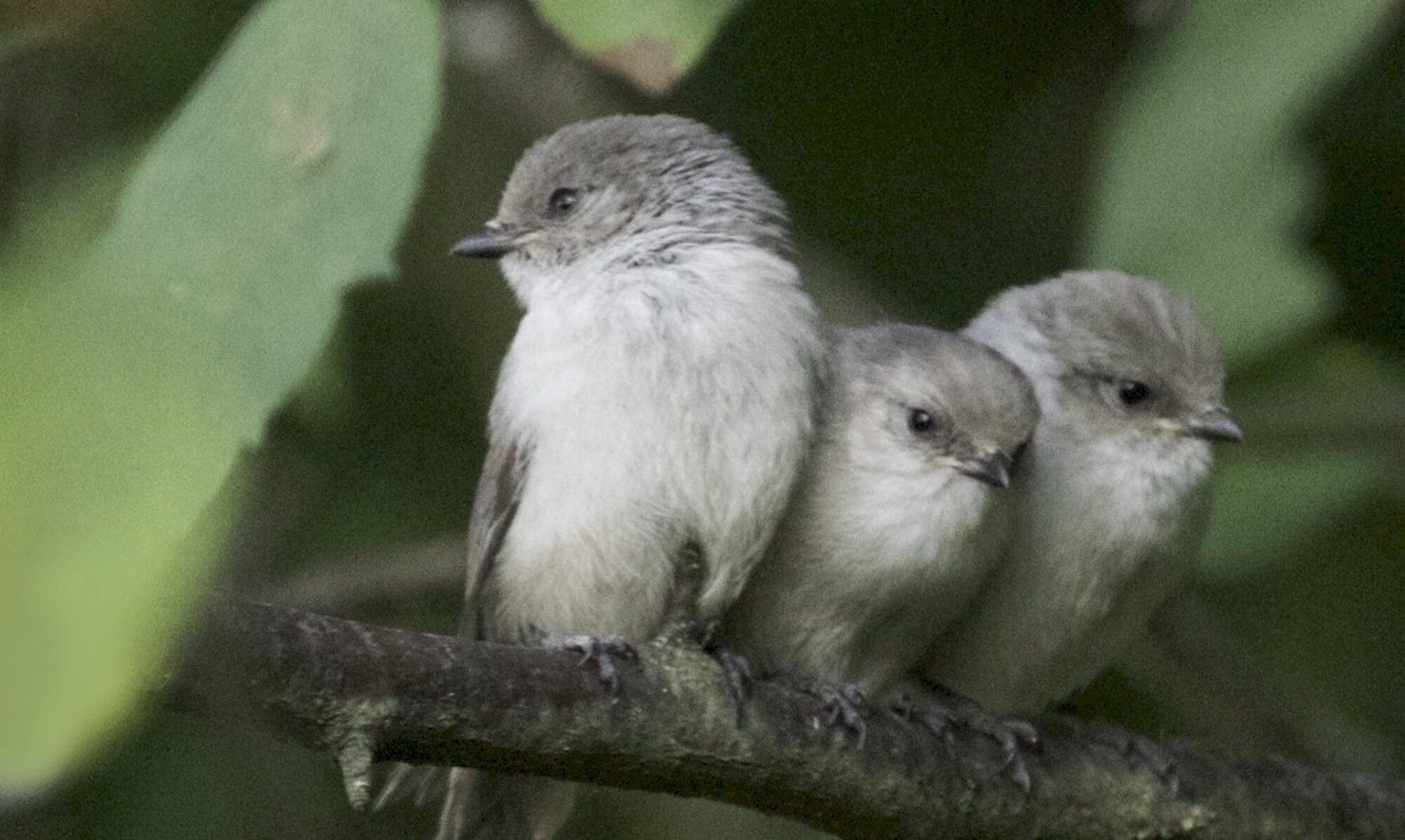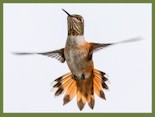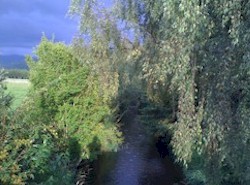
Summer 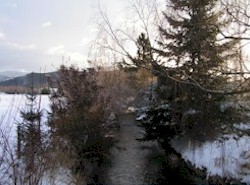
Winter 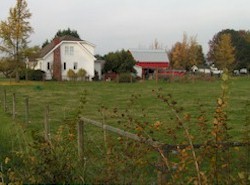
View from the Bridge 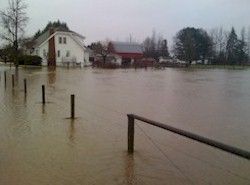
View in Flood
The Enumclaw plateau area provides habitat for many species of wildlife. A great place to find them is along Boise Creek. The creek originates in the foothills east of Enumclaw, flows west through the golf course, across the plateau just south of town, and into the White River. In and along the creek are a variety of fish, amphibians, mammals, rodents, insects, and birds. Many of them are represented on this page.

Click the water gage image below to view both the current water level, as well as historical water levels of Boise Creek near Buckley. At our farm, we begin to experience flooding when the gage reaches 350 cubic feet per second.


Salmon and Trout
Four species of salmon make their way into Boise Creek from Puget Sound each year. They travel up the Puyallup River and into the White River before finding their way into the creek. We first see the salmon at the end of summer when the blackberries along our country roads are ripe The salmon often appear following a day of heavy rain. The first to arrive are usually the Pink (or Humpback) salmon. They show up in great numbers in odd-numbered years and are soon followed in lesser quantities by first the Chinook (or King) salmon and a few weeks later the Coho (or Silver) salmon. Toward the end of the year many Chum (or Dog) salmon come into the creek. The spawning season may last well into December. There is also a spring run of Chinook salmon, but the creek is usually flowing so fast and deep during this time that they are difficult to see.
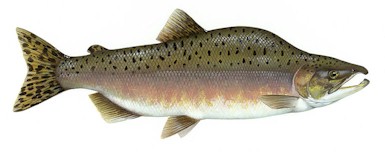
Pink (Humpback) Salmon
Spawns in odd numbered years. 5 to 10 pounds; 10 to 15 inches.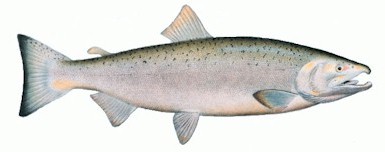
Coho (Silver) Salmon
Spawns every year. 7 to 11 pounds; 28 inches typical.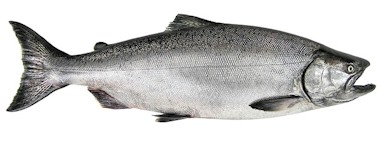
Chinook (King) Salmon
Spawns every year. 10 to 50 pounds; 33 to 36 inches.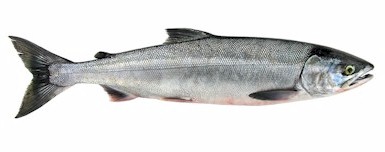
Chum (Dog) Salmon
Spawns every year. 10 to 22 pounds; 24 inches typical.
Here are some salmon videos provided by King County Department of Natural Resources and Parks. They were filmed at the Lower Boise Creek Restoration Project site where Boise Creek flows into the White River. The historic alluvial fan at the mouth of Boise Creek was abandoned a century ago when the railroad relocated Boise Creek into an overly steep ditch. The Lower Boise Creek Channel Restoration Project, completed in 2010, was designed to restore and expand salmon habitat, including spawning for spring and fall Chinook. The project site is now used extensively for spawning and rearing by salmon and trout.
Chinook salmon spawning in Boise Creek (September 25, 2012)
Steelhead spawning in Boise Creek (May 15th, 2013)
Pink salmon do battle in Boise Creek (September 9th, 2013)
Boise Creek supports three species of trout: Cutthroat, Rainbow, and the larger Steelhead. There are far fewer trout than salmon, which is good because all trout are carnivorous, eating fish eggs deposited by spawning salmon. Trout can be found in the creek throughout the year, but are difficult to spot because they are smaller and prefer the deeper, darker places.

Rainbow Trout 
Steelhead Trout 
Cutthroat Trout

Creatures in the Creek

Boise Creek also provides habitat to fresh water lamprey, mussels, small eels, frogs, snails, and crawdad. A myriad of macroinvertebrates thrive along the creek bed; a great indication of good health in this waterway.
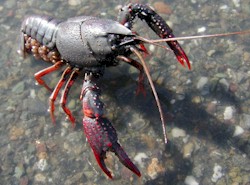
Freshwater Crawdad
Occasionally we see a Crawdad in the creek. These creatures like the darkness and hang out in the mud in places where we’ve seen the Lamprey. They are not afraid when confronted; they will grab onto a stick if you try to poke at them!

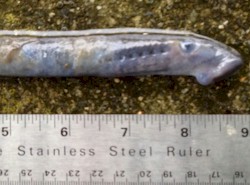
Pacific Lamprey
Lamprey live in muddy areas along the creek and obtain nutrients from the mucky soil. When it is a few years old and a few inches long the Lamprey leaves its muddy home and travels out to sea where it grows up to 30 inches in length. Lamprey return to the creek and spawn, laying tens of thousands of eggs. The Lamprey is a threatened species with numbers in steady decline.


Garter Snake
We often see a Garter Snake slithering along in the tall grass or swimming in the creek. They are very common and easily recognizable with their stripe along the spine for the entire length of their body.

Wildlife Thriving In and Along the Creek
Boise Creek supports several species of wildlife; they depend upon a healthy creek to ensure their survival.
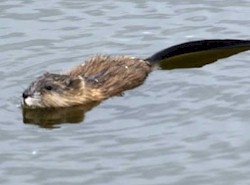
North American Beaver
Beaver occasionally creates a dam or a den somewhere along the creek. We don’t encourage them, because although they are fascinating, beavers dig burrows into the creek side causing portions of the bank to give way. Beavers feed on wood, so they cut down nearby saplings and trees, dragging them into the creek. These trees provide habitat to a variety of birds and create shade that is critical to cooling the creek water. Beavers also use the cut wood to build dams across the creek, creating wide pools upstream. Dams contribute to flooding and create a barrier that prevents salmon from reaching spawning areas upstream..


North American River Otter
The playful, curious otter is a semi-aquatic mammal. It navigates the creek with ease; darting in and out of the water, leaping from rock to rock, and scampering along the tree limbs. The creek is both its hunting ground and play ground. Otters can be hard to spot, because they blend well with the environment. However, they don’t seem to frighten easily and – from a safe distance – they may find you just as interesting to look at as you may find them!

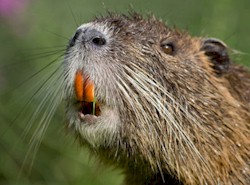
Nutria
The large, omnivorous Nutria is a semi aquatic rodent; is not a northwest native. It has destructive feeding and burrowing behaviors and is considered a pest. We have started to see the nutria only recently, as it seems to like the new Middle Boise Creek Natural Area created in 2013.


Brown Bat
One early morning we discovered that a little Brown Bat had flown in from an open window. It was flapping madly around the room trying to escape. In a flash our cats were in on the action, racing excitedly after it. We removed the cats from the confusion, getting them securely (but resentfully) locked in the bathroom as we tried to coax the bat outside through the open front door. We turned the lights out in the house and turned the porch light on. We quickly realized that this was not a good idea, because bats see better in darkness and tend to avoid the light. We used a fishing net and soon had the poor creature contained. We took it out on the porch and studied it (cool, but kind of creepy) before we let it fly into the early morning darkness. All things considered, it was an interesting way to start the day!

Boise Creek Birds
Along Boise Creek and throughout the nearby countryside are many species of birds, both large and small. They fill the air with their unique songs. Over time, we have tried to identify as many as we could see and hear. To date, we’ve identified well over 100 species along Boise Creek and in the nearly fields and woods.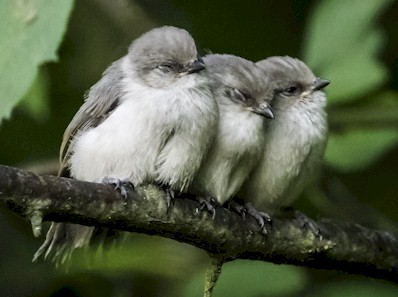

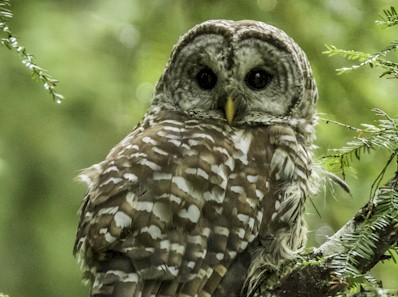
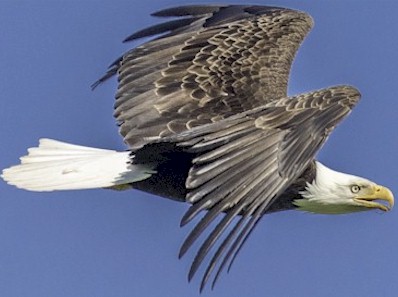
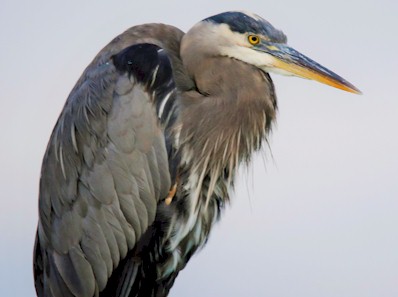
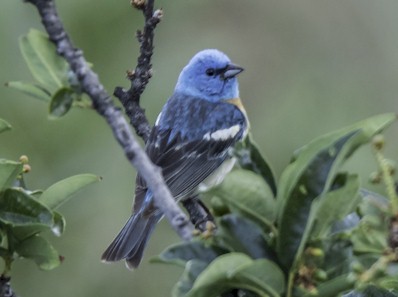
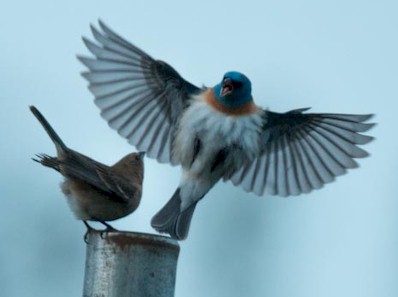
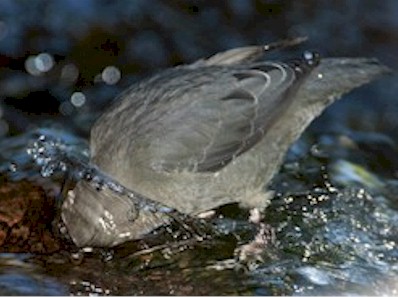
We have spend many happy hours rambling along the creek with our binoculars, delighted and amazed at these wonderful winged marvels.
![]() Visit the Birding section of our site for photos and accounts of the diverse and beautiful birds of Boise Creek.
Visit the Birding section of our site for photos and accounts of the diverse and beautiful birds of Boise Creek.

Larger Animals Along the Creek
Over the years we have spotted various larger wildlife along Boise Creek. We’ve spotted black bear, coyote, elk, deer, bobcat, and many others. Below are some encounters we’ve experienced.

Black Bear
When the salmon spawn and die, the smell of dead fish can become, well… quite nasty. But that’s just our opinion. Little black bears seem to think that this is a delightful aroma. Occasionally, a little black bear will travel at night down the thick wooded hillsides of Mount Peak, pass quietly by sleeping cattle in dark, silent pastures to arrive unseen at the side of Boise Creek. He is seeking a feast worthy of his early fall appetite. In the cover of darkness and thick, thorny bracken he samples the ripe remains of humpies, silvers, and kings. Little black bears are secretive and shy; only the fortunate few ever catch a glimpse of them. But we find evidence of little black bears now and then, beneath the trees along the creek. After the salmon have all spawned and died the little black bears will find a safe, secluded spot within Mount Peak’s dense forest to sleep away the long cold winter days.

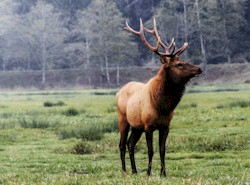
Roosevelt Elk
Sometimes, we hear the sound of a bull elk’s high-pitched bellow as he seeks dominance over other males during the rut. There are a couple of elk herds in the area; roughly thirty to fifty elk are in the herd closest to our place. They range around the Mount Peak and White River area. We often find them in one of the pastures between Raven Hill and Owl Hill, grazing or dozing in the sun. Once in a while we catch them as they move from farm to farm, leaping fences as they go. The elk can be a real nuisance to farmers, causing unnecessary damage to fences, crops, and fields. Very seldom do the elk cross our pasture, but they have done so once or twice, breaking fence posts and knocking down wire. On one occasion we came home to find elk tracks stomped throughout our back yard. To our dismay, the vegetable garden was plundered and the old Japanese lace-leafed maple was thoroughly thrashed. It’s wonderful to have elk in the area, but not in my back yard!


Bobcat
Although we rarely see them – or any evidence of them – the bobcat hunts along the creek. This beautiful feline is larger than a very large house cat and has oversized paws. The bobcat is cautious and highly adept at hiding. We had the chance to see one up close just once. A neighbor found one near his barn one evening. It was crouched unmoving, but growled a warning when he approached. The next morning our neighbor looked for the bobcat, but found that it was dead. Upon examination it appeared to have been hit by a car. We went to see it. We stroked its soft fur with its beautiful markings. The bobcat had wonderful big paws and a short bobbed tail. We were reminded that although we don’t see them, they are living nearby.


Raccoon
In the early morning hours just as it is growing light we can occasionally see raccoons. They prefer the cover of darkness, sharing the night with possum and skunk. In the fall when we have apples and pears on the ground, we like to set out a game camera to capture photos of these creatures as they pass silently through our yard.


Skunk
Our neighbor Terri captured this photo of a skunk family crossing the road in front of our house. Skunk live year round at our place. We’ve found them under our barn, in our loafing shed, and in the ditch culverts. They usually leave you alone if you leave them alone. Once when I was reading down by the creek, a skunk came out of the underbrush and trotted past me within inches of my feet. I froze as he went past. I don’t think he was even aware of me… thank goodness!


Possum
It seems that no one likes the poor slow-witted possum. I feel sorry for them, because I usually only see them after they have been hit and killed by automobiles. Possums are a marsupial; the mother carries her babies in a tiny pouch and when they are older, on her back. It is amazing that these babies survive at all, because they are only the size of a dime when born and quite vulnerable. However, they have not only survived, but the possum has existed since the time dinosaurs roamed the Earth!


Coyote
Only a few years ago we had a large population of coyotes living along Boise Creek. When King County Conservation asked us to join a salmon stream revitalization effort, we were happy to participate. Along with our neighbor upstream, we allowed this group to replant the creek side with native vegetation that now provides shade to cool the creek. These planting have also created a root system to anchor the soil and prevent bank erosion. Before the new vegetation was planted, the group removed a tremendous amount of blackberry bushes. We were delighted to see them go, but the coyotes who sought protective cover in these bushes were not very pleased. These howling, yipping carnivores moved to another location. We are glad they’ve moved on – and so are our cats!


White-tailed Deer
From time to time we spot deer around the Enumclaw plateau area. The deer have a large food supply in the foothills and don’t feed on grass like the elk, so they have little need to venture into the pastures. However, they do like to sample the tasty treats in our gardens. Deer are beautiful animals, but can do a lot of damage to crops. When they become a nuisance, deer fences must be installed. The best places to see deer are in the higher hills as you head up to Mount Rainier.

Some History of Boise Creek
The following paragraph is found on page 25 of Nancy Irene Hall’s book, In the Shadow of the Mountain: A Pioneer History of Enumclaw published in 1983. These are the words of Enumclaw pioneer George Vanderbeck in his later years as he reminisces on his first impressions of Boise Creek:
“In the spring of 1870, I arrived in these regions and looked over the land around Boise Creek. I was surprised and also much pleased with the beautiful stream called Boise Creek although the country was wild and heavily timbered I was fascinated with it. I looked over much of the surrounding country, but could not erase from my mind the beauties of these parts. In those days the camp of the Indian could be seen along the banks of the beautiful stream as well as the wild game that leaped up and took to flight at the approach of the white man. I finally concluded to locate here”.
Note: The Sbalxqo’abc Indian village along Boise Creek was home to the Muckleshoot Indians who traveled Boise Creek and the White River (Hall, 1983, p. 17). The Vanderbecks, from Hanover Germany, were the first to live together as a family on the Enumclaw plateau. Vanderbeck settled 60 acres along Boise Creek near the White River just south-east of our farm, where Mud Mountain Road is today. The area was known as Boise.
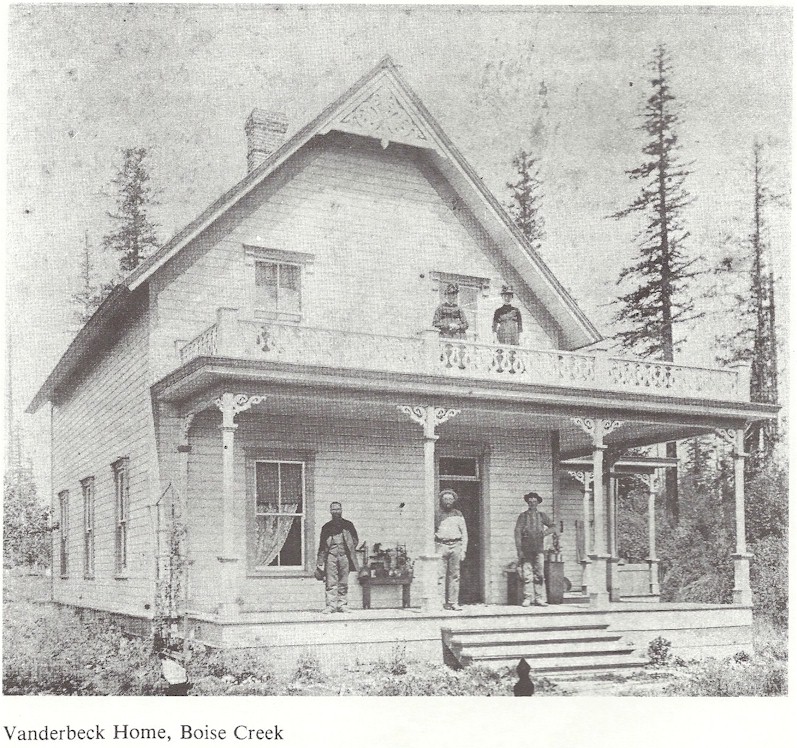
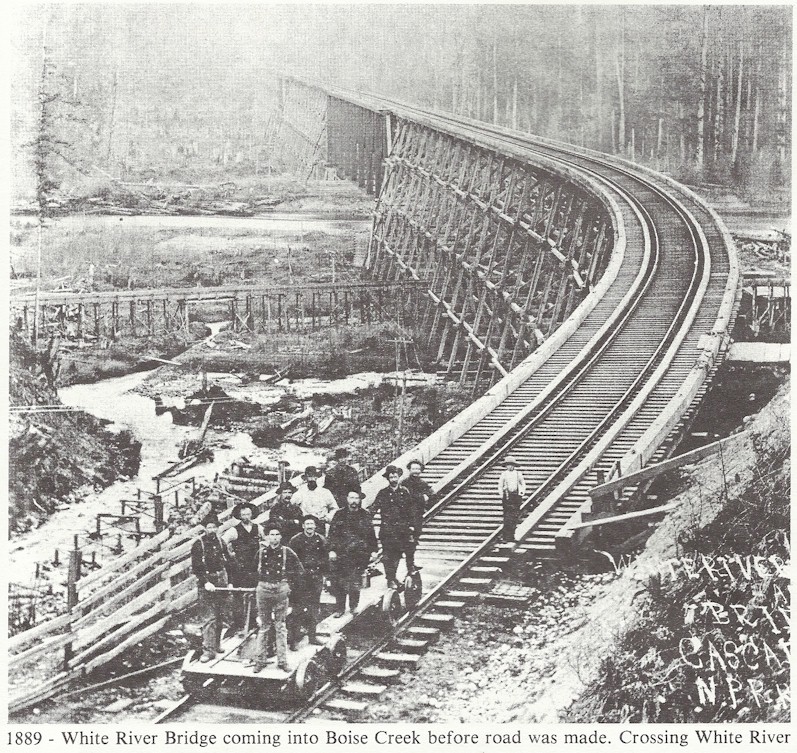
During the twenty-some years that we have lived along Boise Creek, we have come to appreciate and respect the diversity of wildlife around us. Each species depends upon the other to maintain the delicate balance that means survival for all. Most importantly, we have come to realize how each of these species relies upon us to respect and value their lives and their right to exist in a healthy habitat.
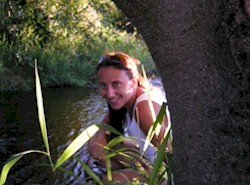
We hope that you’ve enjoyed your cyber nature-tour of the wildlife in and around Boise Creek. Come back and visit our site any time!

